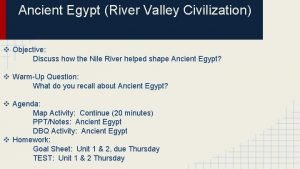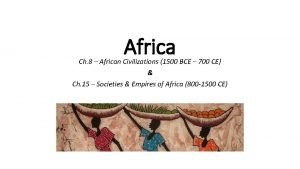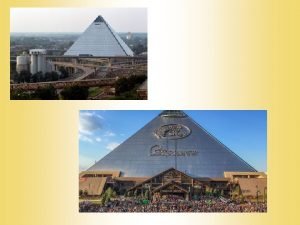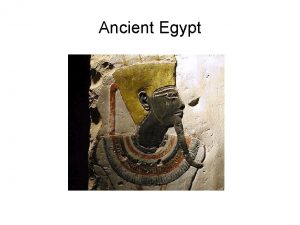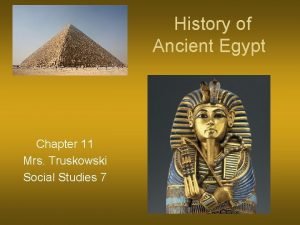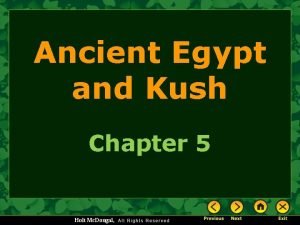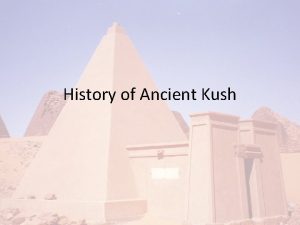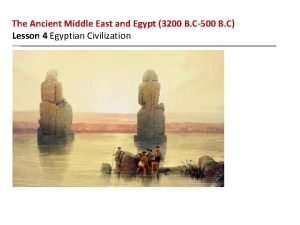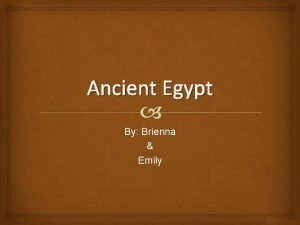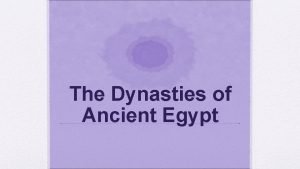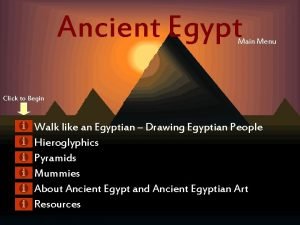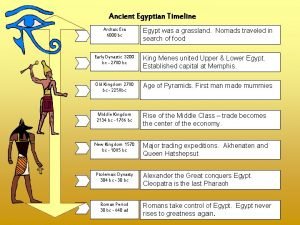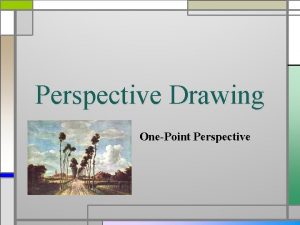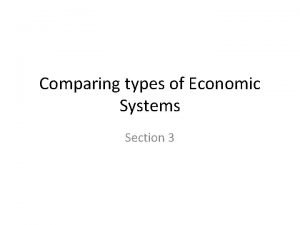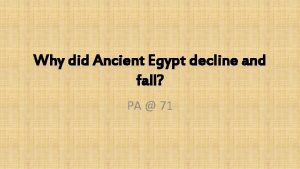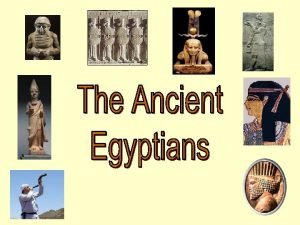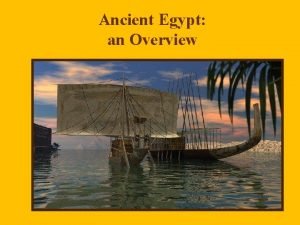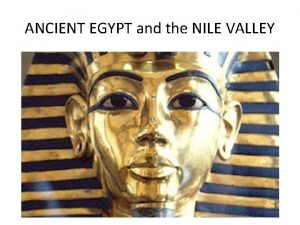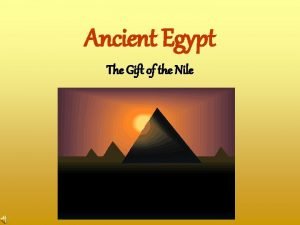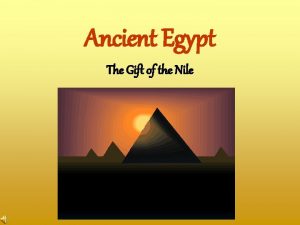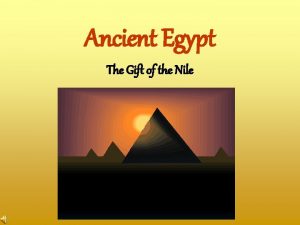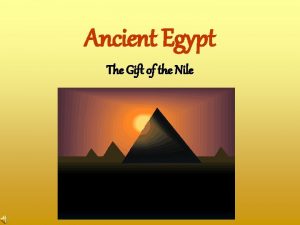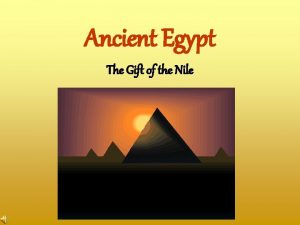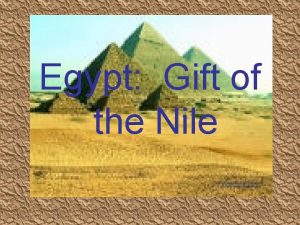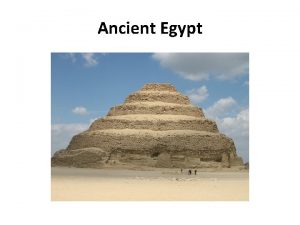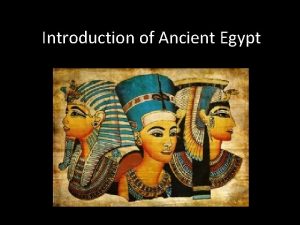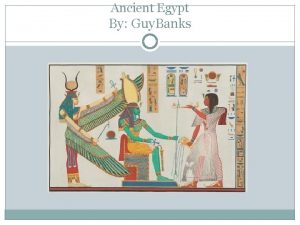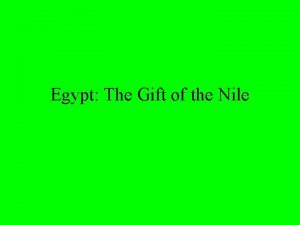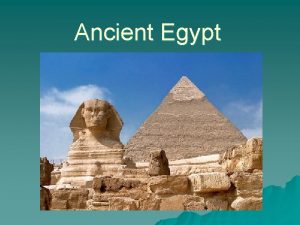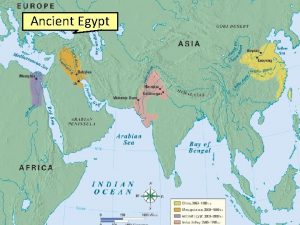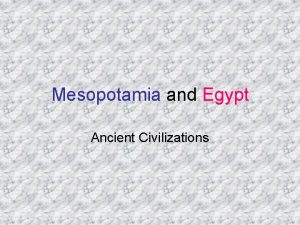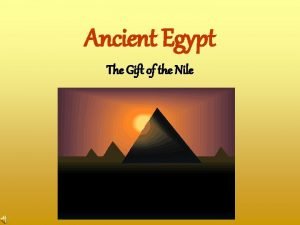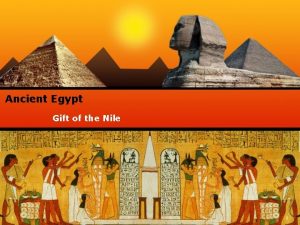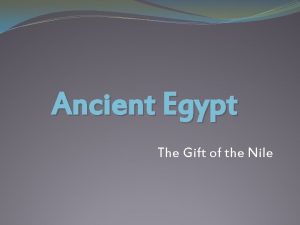Ancient Egypt Gift of the Nile I Gift





























- Slides: 29

Ancient Egypt


Gift of the Nile I. "Gift of the Nile" A. Ancient Egypt was a river valley civilization 1. Very dry climate 2. 9/10 of the land is desert. 3. Almost the entire population lived within ten-fifteen miles of the Nile River.

The Nile River I. Nile River A. The world's longest river, approximately 4, 000 miles. 1. Overflowed each year around the month of April and subsided around October. a. The flood waters were caused by rains in Eastern Africa spread rich deposits of fertile soil along the banks of the Nile River called Silt. b. Enabled food to be easily grown. 2. During the dry season, farmers learned to irrigate the land. a. Irrigation- The watering of dry land by means of streams, canals, and pipes. B. Economy was based on farming. 1. Crops were usually planted in October and were harvested in the spring. https: //www. youtube. com/watch? v=o. E 2 YZZg. ZWd. E

The Nile River flows south to north

Egyptian Society *Egyptian society was made up of many social groups.

Egyptian Society: Slaves I. Slaves A. Made up 20% of the population. 1. Some were children who were often sold into slavery by poor families. a. Most children slaves in Egypt worked as house servants. 2. Most were sold from other countries into slavery in Egypt. a. Many slaves were Jewish who were captured after Israel was conquered by Egypt about 1400 -1200 B. C.

Egyptian Society: Common People II. Common people (Peasant farmers, Craftsmen, and Merchants) A. Made up 70% of the population. 1. Very poor 2. Farmers or various laborers. 3. Enjoyed few privileges 4. Lived and died for one purpose- to work and support the country.

Egyptian Society: Privileged Classes III. Privileged classes A. Made up 9% of the population. 1. Priests a. Because the pharaoh could not perform ceremonies at all the temples throughout Egypt, he appointed high priests to carry out the sacred rituals at each temple. b. Priests enjoyed great power and wealth in Egyptian society. Priests 2. Landlords a. Ran the farms. 3. Government officials a. Held high offices and advised the kings (Pharaohs. ) b. Collected taxes and checked on government projects.

Egyptian Society: Privileged Classes 4. Military leaders 5. Scribes a. Scribes were highly valued members of Egyptian society. b. Responsible for keeping records for the government and in temples. The scribe was very important and many parents wanted to send their kids to scribal school where they could learn to read and write. This would allow them to enter the government of royal services and become rich and powerful. 6. Tradesmen a. Traveled up and down the Nile River trading goods produced in each village. 1 a. To trade goods without money is called Barter.

Egyptian Society: Pharaoh(s) IV. Pharaoh A. Made up 1% of the population. 1. Egyptian supreme ruler. (Most powerful) a. People believed that the pharaohs were descended from the gods and ruled as god's representative on earth. 2. The Pharaohs owned all the land made all the laws. a. Farmers had to pay rent to the Pharaohs to farm the land. 1 a. Sometimes 2/3 of all crops had to be given to the pharaohs.

I. Egypt Before the “Old Kingdom” Before the “Old Kingdom, ” Egypt was divided into Upper and Lower kingdoms. A. Lower Egypt was in the NORTH. B. Upper Egypt was in the SOUTH. • The early people who settled along the Nile River banded together into two main groups. Lower Egypt • One group lived around the mouth of Nile River, near the Mediterranean Sea. Their king wore a Red Crown. Their land was called Lower Egypt. • The other group lived near the mountains to the South. Their king wore a White Crown. Their land was called Upper Egypt • These two groups had much in common. They spoke the same language. They worshipped the same gods. They had the same culture. But, they did not get along and constantly fighting.

“Old Kingdom” II. Old Kingdom (3400 B. C. to 2500 B. C. ) A. Egypt was united under into a single prosperous nation under the leadership of King Menes. B. Memphis became the new Egyptian capital. King Menes conquered Lower Egypt. Both kingdoms continued to fight. One day, King Menes had an idea. If the color of a crown was so important, why not invent a new crown? King Menes created the Double Crown, a mix of white and red. His idea worked!

The Pyramids & Great Sphinx III. Pyramids were built. A. Served as royal tombs where Egyptian Pharaohs were buried. Pyramids were huge structures built to hold a royal tomb. Pyramids had storage rooms, courtyards, secret passageways, and traps to catch robbers who might break into the pyramid. The Great Sphinx is a large humanheaded lion that was carved from a mound of natural rock. It is located in Giza where it guards the front of Khafra's pyramid.

The Pyramids: Diagram

Decline of the “Old Kingdom” IV. Decline of the “Old Kingdom” A. The government during the Old Kingdom grew corrupt. 1. Leaders fought among themselves for power and wealth. a. Civil war erupted and ended the Old Kingdom.

“Middle Kingdom” I. Middle Kingdom: Age of Nobles (2, 500 to 1, 580 B. C. ) A. Egypt was divided into forty regions 1. Governors were appointed to rule each region. B. Egyptian Nobles became very powerful and engaged in a civil war against the Pharaohs. C. Chaos and continued disunity had made Egypt very weak.

Decline of the “Middle Kingdom” II. Decline of the “Middle Kingdom. ” A. About 1700 B. C. , the Hyksos invaded Egypt. 1. Hyksos were desert nomads who were less civilized than the Egyptians. a. The Hyksos had superior weapons and technology. 1 a. Overwhelmed the Egyptians using Chariots. b. The Hyksos conquered and ruled Egypt for over 200 years. 1 b. The Hyksos were very cruel. 2. Egyptians learned to use bronze and horse drawn chariots from the Hyksos and ousted the Hyksos and regained control of Egypt.

“New Kingdom” I. New Kingdom: The Age of Empire (1580 B. C. to 1150 B. C. ) A. The Pharaohs regained full control of Egypt. B. Hatshepsut became the first woman ruler in history. 1. Began the succession of ruling families called dynasties. 2. Expanded Egyptian Empire through trade and conquest. a. Palestine, Phoenicia, Syria, Cyprus, and Nubia. b. Many conquered people became Egyptian slaves. c. Imported gold, ivory, ostrich feathers, fish, and wine. d. Exported glassware, linens, and pottery. 3. Thebes became the new capital of Egypt. In public Hatshepsut dressed like a man and wore a false beard so people wouldn’t know she was a woman.

Decline of the “New Kingdom” C. The Decline of Ancient Egypt (1, 150 B. C. to 31 A. D. ) 1. Egypt was conquered in succession by Libya, Assyria, Persia, and Rome (31 A. D. )

Kingdoms of Ancient Egypt OLD KINGDOM Pharaohs organized a strong central state, were absolute rulers, and were considered gods. Egyptians built pyramids at Giza. Power struggles, crop failures, and cost of pyramids contributed to the collapse of the Old Kingdom. MIDDLE KINGDOM Large drainage project created arable farmland. Traders had contacts with Middle East and Crete. Corruption and rebellions were common. NEW KINGDOM Powerful pharaohs created a large empire that reached the Euphrates River. Hatshepsut encouraged trade. Ramses II expanded Egyptian rule to Syria. Hyksos invaded and occupied the delta region. Egyptian power declined.

Egyptian Contributions: Religion I. Religion A. Ancient Egyptians worshipped many gods. (Polytheism) 1. Examples included: a. Ra (the Sun God) b. Osiris (the God of the Nile. ) B. First conception immortality (life after death. )

Egyptian Contributions: Religion

Egyptian Contributions: Religion

Egyptian Contributions: Art II. Art A. The Egyptians excelled in architecture and sculpture. 1. Great temples, pyramids, and other structures were built. B. Egyptian sculptors carved lifelike statues of men and beasts. C. Beautiful jewelry and other objects of copper and bronze were made.

Egyptian Contributions: Writing III. Writing A. Hieroglyphics 1. A crude system of writing using pictures and symbols. B. Rosetta Stone 1. Discovered in 1799, the Rosetta Stone provided the key to understanding the history of Ancient Egypt. a. Written in Hieroglyphics, late Egyptian, and Greek languages. Rosetta Stone

Hieroglyphics Alphabet Can you spell your name using Hieroglyphics?

Other Contributions Credited to Ancient Egypt IV. Other contributions credited to Ancient Egypt. A. Made paper from Papyrus reed. B. Invented the plow and irrigated their fields during the dry seasons. C. Used geometry for building and surveying. D. Invented the decimal system. E. Used a twelve-month calendar of 365 days, based on the movement of the sun. F. Performed surgical operations in which drugs were used as anesthetics. G. Law and order 1. Laws were very strict and stern. a. Those found guilty were whipped, tortured, burned, or thrown to the crocodiles.

Egyptian Contributions: Science V. Mummification A. Egyptians preserved dead bodies by embalming them. Preparing an Egyptian mummy sometimes took up to 70 days. On some mummies that have been unwrapped, the total length of the bandages has been about 1. 5 miles.
 Egypt is the gift of the nile
Egypt is the gift of the nile How did the nile shape ancient egypt essay
How did the nile shape ancient egypt essay How did the nile shape ancient egypt dbq answer key
How did the nile shape ancient egypt dbq answer key What lasting legacies did the aksum kingdom leave
What lasting legacies did the aksum kingdom leave Upper egypt and lower egypt
Upper egypt and lower egypt Egyptian social class
Egyptian social class Religion
Religion Disadvantages of ancient egypt geography
Disadvantages of ancient egypt geography Specialized jobs in ancient egypt
Specialized jobs in ancient egypt How old is ancient egypt
How old is ancient egypt Pyramid of energy transfer
Pyramid of energy transfer Map of egypt and kush
Map of egypt and kush Rich egyptian clothing
Rich egyptian clothing Map of ancient cush
Map of ancient cush Egyptian hierarchy
Egyptian hierarchy Egypt absolute location
Egypt absolute location Ancient egypt basic needs
Ancient egypt basic needs Ancient egypt vocabulary words
Ancient egypt vocabulary words Workbook page 19
Workbook page 19 What is frontalism
What is frontalism Fomro
Fomro Pharaoh timeline
Pharaoh timeline Ancient egypt
Ancient egypt Economy of ancient egypt
Economy of ancient egypt Non chronological report about egypt
Non chronological report about egypt Why did egypt fall
Why did egypt fall Ancient egypt transportation
Ancient egypt transportation Ancient egypt slogans
Ancient egypt slogans Ancient egypt civilization geography
Ancient egypt civilization geography Three kingdoms of egypt
Three kingdoms of egypt


